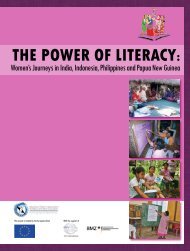Gender Discrimination in Education: The violation of rights of women ...
Gender Discrimination in Education: The violation of rights of women ...
Gender Discrimination in Education: The violation of rights of women ...
You also want an ePaper? Increase the reach of your titles
YUMPU automatically turns print PDFs into web optimized ePapers that Google loves.
which comb<strong>in</strong>e with a preference for educat<strong>in</strong>g boys to<br />
impact girls disproportionately. Basic education should<br />
therefore be both free – genu<strong>in</strong>ely so, with adequate<br />
f<strong>in</strong>ance provided to schools – and compulsory. <strong>The</strong>se<br />
elements have been found to address both the reality and<br />
the perception that it is more valuable to educate boys vi .<br />
In Uganda, the <strong>in</strong>troduction <strong>of</strong> free primary education<br />
caused total girls’ enrolments to rise from 63% to 83%,<br />
and enrolments <strong>of</strong> the poorest fifth <strong>of</strong> girls from 46%<br />
to 82% vii . Given the lack <strong>of</strong> accessibility <strong>of</strong> secondary<br />
education for girls, it is extremely important that States<br />
extend free education to this level, as established <strong>in</strong><br />
General Recommendation 13 <strong>of</strong> CESCR that affirms<br />
“States parties are required to progressively <strong>in</strong>troduce<br />
free secondary and higher education”. Beyond direct<br />
fees for education, it is also necessary to provide support<br />
for the associated costs <strong>of</strong> education, such as school<br />
material, transport and food, which <strong>of</strong>ten lead parents to<br />
keep children out <strong>of</strong> school, particularly dur<strong>in</strong>g times <strong>of</strong><br />
economic hardship. Research published collaboratively<br />
by a number <strong>of</strong> organizations and US universities <strong>in</strong><br />
early 2012 reported that many young <strong>women</strong> <strong>in</strong> postearthquake<br />
Haiti are exchang<strong>in</strong>g sex for payment <strong>of</strong><br />
educational expenses: this is just one shock<strong>in</strong>g example<br />
<strong>of</strong> the cop<strong>in</strong>g mechanisms <strong>in</strong> place when education is not<br />
freely available, and the exploitation that such situations<br />
facilitate viii .<br />
14. Opportunity costs must also be tackled upfront, as<br />
there are important associated gender impacts, related<br />
<strong>in</strong> particular to the above mentioned overall preference<br />
to prioritize boys´ education. Child labour is a central<br />
obstacle to the fulfilment <strong>of</strong> the right to education, with<br />
over one fifth <strong>of</strong> the world’s children aged 5-17 years<br />
be<strong>in</strong>g exploited by child labour, a huge proportion <strong>of</strong><br />
which relates to domestic servants, primarily carried out<br />
by girls. We highlight that “child domestic work is a clear<br />
example <strong>of</strong> how gender identity contributes to the shap<strong>in</strong>g<br />
<strong>of</strong> the different k<strong>in</strong>ds <strong>of</strong> labour. Child domestic labour<br />
patterns correspond to deep-seated, sex-based divisions <strong>of</strong><br />
labour”, be<strong>in</strong>g a clear reflection <strong>of</strong> gender discrim<strong>in</strong>ation ix .<br />
Legislation that combats child domestic labour is key to<br />
overcom<strong>in</strong>g gender associated <strong>in</strong>equalities <strong>in</strong> access to<br />
education. It is worth not<strong>in</strong>g that stipend programs and<br />
conditional cash transfer programs have been employed<br />
<strong>in</strong> sett<strong>in</strong>gs as diverse as Brazil, Yemen, Nepal, Tanzania,<br />
Malawi, Madagascar, Gambia and Kenya, and have<br />
succeeded <strong>in</strong> reduc<strong>in</strong>g girls’ drop-out rates and delay<strong>in</strong>g<br />
early marriage.<br />
15. <strong>The</strong> distance <strong>of</strong> schools and the lack <strong>of</strong> adequate<br />
facilities both have a significant effect on the<br />
accessibility <strong>of</strong> education for girls, particularly <strong>in</strong><br />
terms <strong>of</strong> the provision <strong>of</strong> sanitary facilities for girls. In<br />
research conducted <strong>in</strong> Uganda, 61% <strong>of</strong> girls reported<br />
stay<strong>in</strong>g away from school dur<strong>in</strong>g menstruation x . A lack<br />
<strong>of</strong> adequate, separate facilities and can also <strong>in</strong>crease<br />
vulnerability to and fear <strong>of</strong> sexual assault and violence.<br />
Similarly, when children have to travel long distances<br />
to school, parents are more likely to prevent girls from<br />
go<strong>in</strong>g to school because <strong>of</strong> fears for their safety xi . This<br />
requires both greater provision <strong>of</strong> schools <strong>in</strong> rural areas<br />
and mechanisms to ensure safe transport, which may be<br />
as simple as ensur<strong>in</strong>g adult accompaniment for children<br />
travell<strong>in</strong>g to school.<br />
16. Address<strong>in</strong>g the lack <strong>of</strong> female teachers is a<br />
significant element <strong>in</strong> mak<strong>in</strong>g education more<br />
acceptable for girls. This can have a direct impact on<br />
enrolment, with the correlation especially strong <strong>in</strong> sub-<br />
Saharan Africa and at secondary level xii . Yet only around<br />
one third <strong>of</strong> secondary school teachers <strong>in</strong> South and West<br />
Asia are female and fewer than three <strong>in</strong> 10 <strong>in</strong> sub-Saharan<br />
Africa. Disparities can be even greater at tertiary level:<br />
<strong>in</strong> Ethiopia, for example, fewer than 1 <strong>in</strong> 10 tertiary level<br />
teachers are female. <strong>The</strong> absence <strong>of</strong> <strong>women</strong> teachers from<br />
this level is perpetuated and exacerbated by the systemic<br />
lack <strong>of</strong> opportunities for girls and <strong>women</strong> to access<br />
required skills and tra<strong>in</strong><strong>in</strong>g xiii . Those <strong>women</strong> who do<br />
enter teach<strong>in</strong>g can suffer gender discrim<strong>in</strong>ation <strong>in</strong> their<br />
pr<strong>of</strong>ession: the prelim<strong>in</strong>ary results <strong>of</strong> GCE’s global teacher<br />
survey show a huge 30% <strong>of</strong> female teachers report<strong>in</strong>g that<br />
they have experienced gender discrim<strong>in</strong>ation. In regions<br />
where the teach<strong>in</strong>g pr<strong>of</strong>ession has become fem<strong>in</strong>ized,<br />
however, this has <strong>in</strong> some cases contributed to its low<br />
status and pay. <strong>The</strong>re needs to be simultaneous efforts<br />
to raise the status <strong>of</strong> the teach<strong>in</strong>g pr<strong>of</strong>ession, whilst<br />
support<strong>in</strong>g greater female participation <strong>in</strong> regions where<br />
this is very low.<br />
17. Mak<strong>in</strong>g education more acceptable for girls also<br />
<strong>in</strong>volves ensur<strong>in</strong>g that the curriculum, the classroom<br />
and school culture are <strong>of</strong> high quality, uphold <strong>rights</strong>,<br />
and are relevant and safe. In terms <strong>of</strong> curriculum<br />
reform, a greater emphasis is needed both on <strong>in</strong>clud<strong>in</strong>g<br />
equal and positive representation and images <strong>of</strong> <strong>women</strong>,<br />
and <strong>in</strong> ensur<strong>in</strong>g that relevant skills and knowledge –<br />
<strong>in</strong>clud<strong>in</strong>g around sexual and reproductive health – are<br />
<strong>in</strong>cluded. Along with improvements <strong>in</strong> the overall quality<br />
<strong>of</strong> education, these curriculum reforms could do much<br />
to address perceptions and reality <strong>of</strong> the low value <strong>of</strong><br />
education, which acts as a dis<strong>in</strong>centive for parents to<br />
educate their daughters. In terms <strong>of</strong> classroom culture,<br />
teachers must ensure full participation <strong>of</strong> <strong>women</strong> and<br />
girls <strong>in</strong> the classroom – which itself may <strong>in</strong>volve a break<br />
with cultural norms – and schools need to work harder<br />
to avoid direct<strong>in</strong>g boys and girls <strong>in</strong>to subjects, activities<br />
and games deemed ‘appropriate’ for their gender. GCE’s<br />
survey showed that overall around half <strong>of</strong> pupils still<br />
tend to identify so-called ‘s<strong>of</strong>t’ subjects with girls, and<br />
more technical subjects with boys, with the associations<br />
strongest <strong>in</strong> South Asia. <strong>The</strong> majority <strong>of</strong> pupils were<br />
aware <strong>of</strong> games that they described as be<strong>in</strong>g “only” for<br />
girls or for boys. School safety is a huge issue for girls: at<br />
their best, schools can provide girls with protection from<br />
violence and abuse, through the act <strong>of</strong> educat<strong>in</strong>g them; at<br />
their worst, they are a site <strong>of</strong> abuse. Surveys conducted by<br />
GCE members <strong>in</strong>dicate that violence aga<strong>in</strong>st and abuse<br />
<strong>of</strong> girls <strong>of</strong>ten exists alongside a culture <strong>of</strong> impunity, <strong>in</strong><br />
which abuse is rarely reported or punished. Required<br />
action <strong>in</strong>cludes not only monitor<strong>in</strong>g and enforcement <strong>of</strong><br />
legislation, but improved school <strong>in</strong>frastructure, tra<strong>in</strong><strong>in</strong>g<br />
for teachers and parents, more female teachers and<br />
curriculum reform.<br />
7<br />
<strong>Gender</strong> <strong>Discrim<strong>in</strong>ation</strong> <strong>in</strong> <strong>Education</strong>: <strong>The</strong> <strong>violation</strong> <strong>of</strong> <strong>rights</strong> <strong>of</strong> <strong>women</strong> and girls
















